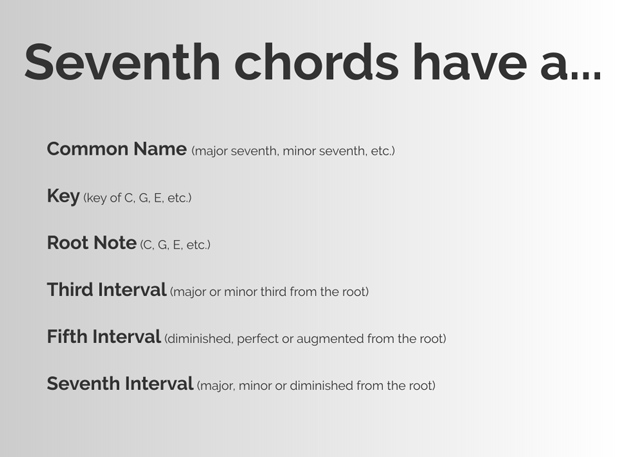Guitar Chalk Sessions: A Clean Guide to Understanding Seventh Chords
Take a look at the theory behind seventh chords, and learn how to build them from the ground up.

We can always memorize new chords. That’s not hard.
But what if we learned the structure and the music theory behind those chords first? What if we put the time into gaining a complete, academic understanding of what we’re playing?
People shy away from music theory because it’s hard. And I’m not going to tell you otherwise.
Quite the opposite, in fact; music theory is incredibly difficult.
But if you take it one piece at a time, theory isn’t nearly as daunting, and it eventually comes together as you understand why you’re playing what you’re playing.
It’s a better alternative to raw memorization because it provides structure.
Learning and memorizing, though they can cross paths, are not the same and certainly don’t benefit the human mind in the same manner.
All the latest guitar news, interviews, lessons, reviews, deals and more, direct to your inbox!
So we’ll tackle some real, substantive learning by looking at the theory behind seventh chords. We’ll learn how to build them from the ground up.
Step 1: Learn the Formal Definition of Chords and Triads
To begin, we need to know the formal definitions of a chord and, more importantly, a triad.

Chords are straightforward, either two/three or more notes depending on who you ask. Now, a triad:

Howard Hanson and Carlton Gamer, 20th-century music theorists, expanded the term “triad” to refer to any collection of three different pitches, regardless of interval. While that definition is more palatable, we need to stick with the formal definition here.
Thus, our triads are constructed in three parts:
01. A root note
02. Third interval (major or minor)
03. Fifth interval (diminished, perfect or augmented).
The following is an example of a triad.

In order to find each interval, we have to count semitones (frets) from the root note. For example, a perfect fifth is seven frets from the root, a major third is four frets from the root and so on.
If you’re comfy, we’re ready to define and build our seventh chord.
Step 2: Learn the Formal Definition of a Seventh Chord
Yes, they have a “bluesy” sound, but what does that mean? A seventh chord is a triad with an added seventh interval from the root. That seventh interval can be either major, minor or diminished, and is typically what makes the chord sound bluesy.
Thus we need the following components to build our seventh chord:

When building our seventh chords, we want to focus primarily on the root note and the three additional intervals. To do that, we’ll build two common (tertian) seventh chords:
01. Major Seventh
02. Minor Seventh
We’ll start with a root note, examine the necessary intervals for our chord (available on the seventh chord wiki page) and then build out accordingly.
1: Major Seventh
Interval Pattern: Major Third - Perfect Fifth - Major Seventh
Consider the following root note:
Per the interval pattern, we can start by adding a major third and perfect fifth. The major third is four semitones above the root while the perfect fifth is going to be seven semitones above the root.
If you count straight up, seven spots from the second fret on the sixth string, the note you fall on is C#. That means the same C# note at the fourth fret on the fifth string will suffice as our perfect fifth. The same reasoning can be applied to the major third (third string and third fret).
We can use the same counting tactic to place our major seventh interval.
Our major seventh interval (an F) falls on the fourth string at the third fret. How did we get there?
If we know that a major seventh interval falls 11 semitones from the root note (from this graphic), which is an F sharp, we count up 11 frets giving us our F, which can also be played at the fourth string on the third fret.
2: Minor Seventh
Interval Pattern: Minor Third - Perfect Fifth - Minor Seventh
Start with the following root note.
Per the interval pattern, we add a minor third and perfect fifth.
The perfect fifth is easy, since it forms a power chord shape (fifth string, seventh fret) with our root note. Since a minor third on the fifth string falls at the third fret (three semitones above the root) we can use the octave of that note on the third string at the fifth fret, to grab our minor third.
Lastly we add our minor seventh interval, falling ten frets up from the root.
Ten frets up from the root note (A) would be a G, which can be played by your pinky finger on the second string at the eighth fret.
Other Chords and Resources
Some other tertian seventh chords would include the dominant, diminished and half-diminished. Now that you know how to build a seventh chord, it’ll be a great deal easier to understand and memorize others.
Best of luck!
Robert Kittleberger is the founder and editor of Guitar Chalk and Guitar Bargain. You can get in touch with him here, or via Twitter, Facebook and Google Plus.
Bobby is the founder of Guitar Chalk, and responsible for developing most of its content. He has worked with leading guitar industry companies including Sweetwater, Ultimate Guitar, Seymour Duncan, PRS, and many others.

